Walking a Few Thousand Steps Daily May Reduce Alzheimer’s Risk, New Study Suggests

© Nicholas Sansone for The New York Times

© Nicholas Sansone for The New York Times



编者按:《CDT报告汇》栏目收录和中国言论自由及其他人权问题相关的报告资讯。这些报告的来源多种多样,包括机构调查、学术研究、媒体报道和网民汇集等等。也欢迎读者向我们推荐值得关注的报告。
中国数字时代本周推荐媒体:
维权网:是关注中国人权的非政治性非营利的知名公益组织,由一群志愿者运营。其每个月都会发布的《中国大陆在押政治犯、良心犯月度报告》,是记录中国维权人士遭遇的重要平台。
10月29号,美联社发布了一篇调查新闻。他们发现,尽管历届美国政府公开警告中国在国家安全及人权方面的风险,但无论是民主党还是共和党执政,美国政府不仅多次允许,还在某些情况下主动协助美国企业向中国警方、政府机构及监控公司出售敏感技术。报道批评称,这些技术被用于构建中国的监控体系,引发争议。

文章封面截图
报道指出,自2023年9月以来,美国国会曾四次尝试关闭一项关键的出口漏洞,即中国企业绕过芯片出口禁令,通过美国云服务租用高性能AI芯片。但每一次立法都因科技企业及行业协会逾百名游说人士介入而失败。与此同时,仅在2024年,中国就从美国企业购买了价值207亿美元的芯片制造设备。
更具争议的是美国政府与企业之间的合作。美联社披露,特朗普政府在今年8月同意解除对英伟达 (Nvidia) 和AMD的先进芯片出口限制,以换取15%的销售收入分成,并宣布政府持有英特尔10%的股份。对此,民运人士周锋锁批评称:“美国政府让企业主导议程,忽视它们如何帮助北京监控和审查人民……这是战略性的失败。”
美联社还通过调查公开记录、会议证词、游说文件及数十次现任官员访谈指出,美国政府曾通过商务部下属的美国商业服务机构,为本国企业与中国公安系统牵线搭桥。早在2007年,美国商务部就曾举办题为“如何向中国安全市场销售监控工具”的讲座,并提供“市场渗透策略”。
文章批评称,美国政府对外“公开强硬”,但私下仍与企业合作:“即便在警告国家安全和人权侵害问题的同时,美国政府……仍一再允许甚至积极协助美国企业向中国警方、政府机构及监控公司出售技术。”
此外,云服务成为新的漏洞。尽管一些中国企业被列入制裁名单,但它们依旧可通过微软 Azure 和亚马逊 AWS 使用高性能计算及视频监控存储服务。例如,国有企业国投智能公司曾寻求访问 AWS 和 Azure 的大数据平台;上海齐治研究院则计划采购价值 28 万美元的 Azure OpenAI 服务。美联社还发现,尽管微软称未与受制裁的中国企业海康威视合作,但公开资料显示,海康威视仍使用 AWS 向海外提供 “HikCentral” 监控平台。
美联社还引用新疆维吾尔族幸存者古丽巴哈尔·海提瓦吉的证词。她曾因中国警方使用基于美国技术的监控系统被标记为“恐怖分子”。她表示,“再教育营”中“连厕所都装有摄像头”。她控诉说:“美国明知后果严重,却仍出售这些技术,令人失望。”
在国会层面,关闭漏洞的努力持续受阻。众议员克里斯·史密斯 (Chris Smith) 表示:“我们过于天真甚至共谋……把足以摧毁西方民主的能力卖给一个敌对政权。”民主党参议员罗恩·怀登 (Ron Wyden) 则批评称:“这些公司的共同点就是为了钱。”尽管拜登政府将中国监控技术公司列为“非凡威胁”,并提出限制面部识别与 AI 设备出口,但相关规则仍因企业反对而被搁置。
最后,美联社指出,美国科技企业在中国监控体系中的角色远超公众认知,而政府在经济利益面前的犹豫,使人权与国家安全问题持续陷入僵局。
达里娅·因皮翁巴托 (Daria Impiombato) 是一位中国问题专家,曾在澳大利亚战略政策研究所(ASPI)工作,并因研究维吾尔人权问题而知名。
近日,她在《外交家》杂志 (The Diplomat) 上刊文,指出西方国家对跨国镇压 (transnational repression) 问题的关注正在上升,然而欧盟却仍未能建立足够有效的防护机制,来保护居住在欧洲的异议人士、少数族裔与海外华人社区。文章称,中国等威权国家正在通过合法与隐蔽手段在欧洲境内施压异议人士,而“欧洲对此准备不足,执法体系与保护机制存在明显漏洞”。

文章封面截图
文章引述欧洲议会一份研究报告称:“欧盟成员国在履行保护面临危险的人权维护者的义务方面未能尽责。”据悉,G7 国家今年 6 月联合承诺加强合作以反制跨国镇压,联合国人权事务高级专员也呼吁各国对应此类行为“零容忍”。
然而,文章指出,北京已形成系统性策略,针对对象包括异议人士、维吾尔人、西藏人、港人、记者、学生和流亡政治活动者。不仅通过官方渠道如引渡协定、国际刑警组织红色通缉令施压,还广泛依赖“秘密手段”,例如网络入侵、监控、威胁在华家属等。国际调查记者联盟 (ICIJ) 今年披露,在 23 个国家(其中包括 10 余个欧洲国家)发现“中国跨国镇压”案例,称其为一场“精心策划的全球性活动”。
例如,中国通过国际刑警组织扩大海外执法影响。文章称,北京频繁使用“红色通缉令”请求,使欧洲警方卷入“政治动机驱动的拘捕”。尽管欧洲人权法院在 2022 年以“中国政权具有威权性质”为由确立拒绝引渡的先例,但部分国家仍与中国签署或推动新的引渡协议。比如文中提到,“中国近日与匈牙利敲定了新的引渡条约,据报道该条约还允许中国执法人员与匈牙利警察共同巡逻。”
此外,隐性恐吓也在蔓延。文章提到,今年有两名外国代理人因雇人恐吓批评习近平的美国居民而被捕。达里娅指出,此类行为“破坏社区内部信任,助长自我审查,并削弱侨民知识储备”。
报道强调,仅靠惩治间谍或外交层面抗议是不够的。“若仅将跨国镇压视为国家间干涉,则可能掩盖更隐蔽的镇压形式。”因此,她建议欧盟必须制定法律定义,建立跨机构监测和数据收集机制,并将处理跨国镇压纳入欧洲刑警组织的权限。
文章还建议欧盟应借鉴加拿大经验。例如,加拿大将跨国镇压视为“加拿大主权和民主面临的最大战略挑战之一”,成立“外国干涉监察机构”、推动外国代理人登记制度,并通过新立法。
最后,达里娅警告称,如果欧盟仍停留在政治表态而非实际行动,“威权国家就将继续在欧洲境内恐吓社区,侵蚀欧洲本土的民主韧性”。因此,欧盟需要采取行动,刻不容缓。
维权网(公民维权志愿者联网组织)于 2025 年 10 月 31 日发布《十月中国大陆在押政治犯、良心犯月度报告》。报告显示,上期名单中的 32 人已刑满释放,并获悉有 2 名被羁押者被判刑,22 人狱中有新动态。同时,本期新增被刑事拘留 28 人以及被判刑 24 人,共计 52 人。被捕的主要原因包括从事宗教活动、少数民族维权、维权上访以及参与民主人权活动等。
1. 本月获悉上期名录中刑满释放的 32 人名单:
王巧芳、崔建秀、邓天玉、季玮、李华、
李巧莲、李新、刘红霞、刘敏娜、刘庆余、
刘卫汝、刘珍俐、马海云、潘晶、帅仁兵、
司孝洪、唐雪英、王凤英、王迦勒、徐永清、
杨波、杨树珍、曾琴玲、张娟、周海燕、
陈如勇、李桂林、赵云峰、付雁丽、石锐、
杨桂娟、余钱
2. 本期获悉狱中羁押者遭判刑的 2 人名单:
9 年:彭立发
4 年:赵春红
3. 本期新增被刑事拘留的 28 人名单:
李贵文、黄琳婷、胡洋、马树涛、李向阳、
“109 锡安教案”:金明日、王林、刘江、孙聪、高颖佳、尹会彬、刘炳彬、稳成林(原名:林书斌)、孙学、汪中。被羁押的十三位女性信徒包括:王聪、杨丽君、米沙(原名:魏云斐)、明丽(原名:朱明立)、崔晓乐、吴小雨、李盛娟、胡燕子、战歌、图雅、安梅、黄春子、M 姐妹。

锡安教会牧师金明日,图片来自维权网
4. 本期新增被判刑的 24 人名单:
8 年:白鸿敏、
7 年:侯秀英、
6 年:李玉芬、
5 年 6 个月:吕先锋、樊云鹏、杜长江、
5 年:李瑞花、
4 年 9 个月:盛桂兰、
4 年 6 个月:杨福军、
4 年:张芝榕、刘金果、
3 年 6 个月:袁轶群、王君平、
3 年 5 个月:左秀云、
3 年 3 个月:王杏妹、
3 年:吴少川、余梅、
2 年 6 个月:郭海成、赵彩霞、
2 年:李庆胜、朱细霞、
1 年 6 个月:李坤芳、王均恒、
1 年:李桂芹
报告称,截至目前,中国共有 1706 名在押政治犯、良心犯,其中死缓 11 人、无期徒刑 17 人、有期徒刑 1419 人,刑期不明 28 人,羁押未判 259 人,另有大量人员被精神病或强迫失踪情况未完全记录。
每位政治犯、良心犯的被捕原因详情可访问维权网:《维权网:中国大陆在押政治犯、良心犯月度报告(2025 年 10 月 31 日)第121期(共1706人)》。

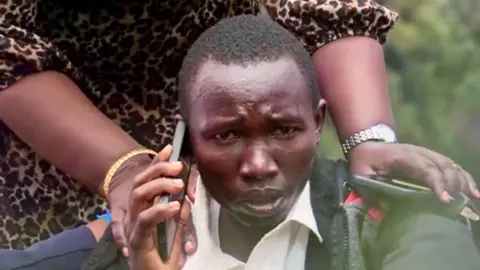 Duncan Wanga
Duncan WangaMore than 40 people are now known to have died after multiple landslides struck Kenya and Uganda's mountainous border region last week.
"I lost a grandmother, a maternal aunt, an uncle, two sisters, a family friend and a cousin. They were staying together in Kaptul village," Felix Kemboi told the BBC on the Ugandan side.
So distressed was the 30-year-old Felix that he struggled to put the experience into words.
On both sides of the border, many people are still missing and search and rescue teams have been sent out to find them, amid warnings that more landslides could occur.
"As heavy rainfall continues to be experienced across several parts of the country, the risk of landslides, especially along the Kerio Valley region, is heightened," warns Kenyan Interior Minister Kipchumba Murkomen.
He is urging residents of affected areas to be cautious of any earth movements and says local authorities are moving those at risk to higher ground.
Fourteen schoolchildren were among the dozens of Kenyans killed when two mudslides struck the Great Rift Valley area, according to the country's education ministry.
Survivors in eastern Uganda have shared terrifying accounts with the BBC.

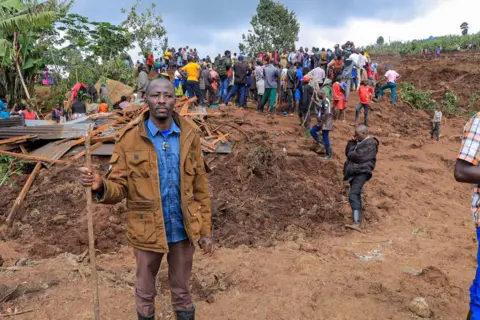 Uganda Red Cross Society
Uganda Red Cross Society"We were sleeping at night, we [heard] a huge sound. The neighbours came running. 'You wake up'. The mountain is coming. My niece and brother died," recalls Helda Narunga Masai.
Her home in Kween village was destroyed in the mudslide and she is now staying with a neighbour.
About 14km (eight miles) up the road, in Kapchorwa, three children and woman from the same household were killed.
Uganda Red Cross workers say at least 18 people have died in the country's east, and their staff plus community volunteers are searching for the 20 people still unaccounted for across Kapchorwa, Bukwo and Kween districts.
Mande David Kapcheronge, a local leader, has told the BBC that the rescue teams are using rudimentary tools to dig up heaps of mud in the recovery.
Experts have warned against building homes in some of the affected areas in Uganda and Kenya, where landslides are a known problem.
In 2010, a landslide in the Ugandan town of Bududa killed about 300 people, making it one of the country's most devastating natural disasters.
In response to this latest disaster, the Ugandan government is paying bereaved families 5m shillings ($1,300; £1,000) and 1m shillings to each survivor.
The Kenyan government has yet to announce compensation for survivors or the bereaved.
In Uganda, search missions have been hampered by the mudslides cutting off access to some roads.
Additional reporting by Natasha Booty

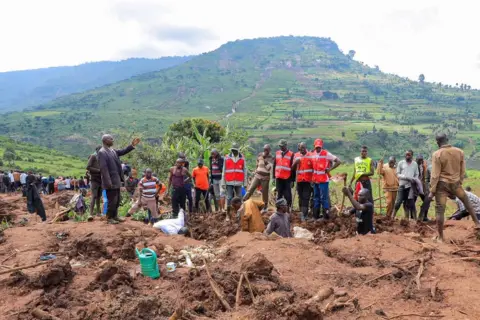 Uganda Red Cross Society
Uganda Red Cross Society
 Getty Images/BBC
Getty Images/BBCGo to BBCAfrica.com for more news from the African continent.
Follow us on Twitter @BBCAfrica, on Facebook at BBC Africa or on Instagram at bbcafrica

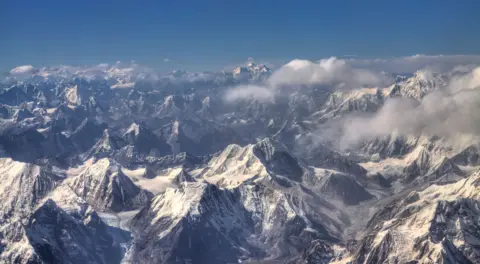 Getty Images
Getty ImagesAt least three climbers, including a French national and two Nepalese people, have died after being hit by an avalanche on a Himalayan peak in north-eastern Nepal, police say.
The incident happened at 09:00 local time (03:15 GMT) on Monday near the base camp of the Yalung Ri mountain in Dolakha district.
A further four climbers - two Italians, a German and a Canadian - are feared dead but a search for them is continuing. The killed and missing were part of a group of 12 trekkers and local guides that set out over an hour before the avalanche hit, the district police chief told the BBC.
Five Nepali guides who returned to the base camp were injured but not critically.
"Three bodies have been seen and rescue teams have to find four more," local deputy superintendent of Police Gyan Kumar Mahato told the BBC.
It is not clear if the other two confirmed dead, who are both Nepali, were working with the group or were climbers themselves.
Mr Mahato said a rescue helicopter had landed on Monday in the Na Gaun area of Dolakha - a five-hour walk from the Yelung Ri base camp.
Efforts to locate those still missing have been hampered by poor weather and logistical issues, according to local media reports.

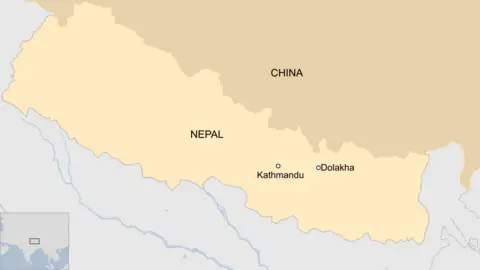
Separately, attempts to rescue two Italian climbers who went missing while attempting to scale the Panbari mountain in western Nepal are continuing.
Stefano Farronato and Alessandro Caputo were part of a three-man group that became stranded along with three local guides last week. The third member of the group, named in media reports as Velter Perlino, 65, has since been rescued.
Autumn is a popular season for trekkers and mountaineers in Nepal as weather conditions and visibility have tended to be better. However, the risk of severe weather and avalanches remains.
Last week, Cyclone Montha triggered heavy rain and snowfall across Nepal, stranding people in the Himalayas.
Two British and one Irish woman were among a group that had to be rescued after being trapped for several days in the western Mustang region.
Severe weather also left hundreds of hikers stranded near Mount Everest in October.
Part of a medieval tower in the heart of Rome's tourist district has collapsed, trapping one man and leaving another critically injured.
A section of the Torre dei Conti, on the edge of the famous Roman Forum and close to the Colosseum, gave way just after 11:30 local time (10:30 GMT).
"It's a very complex situation for the firefighters because there is a person trapped inside," Rome Prefect Lamberto Giannini said. The man is conscious and communicating with rescue workers.
The tower has been closed to the public for many years, and was undergoing conservation work when a section collapsed.
While rescue efforts were still under way, a second section of the 29m (90ft) high tower began crumbling again, with bricks raining down, creating a huge cloud of dust.
The firefighters were unharmed, pausing their rescue work for a time, but then continuing their search for the missing man.
After the initial collapse, firefighters "put up some protection" around the trapped man, so when the second collapse happened, "they obviously shielded him", Lamberto Giannini said.
"It will be a very long operation because we have to try to save the person, but we also have to try to mitigate... the enormous risks faced by the people trying to carry out the rescue," he added.
A police chief has said there is no imminent danger that the tower will disintegrate.


One worker was taken to hospital in a critical condition, local and foreign news agencies report.
Another worker, 67-year-old Ottaviano, who was inside at the time of the collapse but escaped from a balcony uninjured, told AFP news agency: "It was not safe. I just want to go home."
Rome's mayor and the country's culture minister have visited the scene. A crane and drone are also being used to assist with the rescue operation.
The 13th Century tower is part of the Roman Forum, a major tourist attraction right in the heart of the city, but it is separated from the main visitors' area by a road. The streets all around have been taped off by police as a precaution.
The medieval tower was built by Pope Innocent III as a residence for his brother.
US President Donald Trump has said he would be reluctant to send federal funding to his hometown of New York City if left-wing front-runner Zohran Mamdani is elected mayor of America's biggest city this week.
"It's gonna be hard for me as the president to give a lot of money to New York, because if you have a Communist running New York, all you're doing is wasting the money you're sending there," Trump said in a television interview.
The Trump administration has repeatedly tried to cut federal grants and funding for projects primarily located in Democratic-run areas.
Opinion polls indicate Mamdani is ahead of his main rival, former New York Governor Andrew Cuomo, on the eve of Tuesday's vote.
Trump did not elaborate on his remark about funding should Mamdani win. New York City received $7.4bn (£5.7bn) in federal funding this fiscal year.
In a wide-ranging interview with CBS programme 60 Minutes on Sunday, Trump said that a Mayor Mamdani would make left-wing former New York City Mayor Bill de Blasio "look great".
"I got to see de Blasio, how bad a mayor he was, and this man will do a worse job than de Blasio by far," the president said of Mamdani.
Trump, who grew up in the New York borough of Queens, also effectively endorsed Cuomo, a Democrat, in the interview.
"I'm not a fan of Cuomo one way or the other, but if it's gonna be between a bad Democrat and a Communist, I'm gonna pick the bad Democrat all the time, to be honest with you," the Republican president said.
Mamdani, who would run a world financial hub, is a self-described democratic socialist, though he has rejected accusations he is a communist, joking in one television interview that he was "kind of like a Scandinavian politician", only browner.

 Getty Images
Getty ImagesMamdani won the Democratic primary, while Cuomo came second. The 34-year-old state assemblyman has called the former New York governor a puppet and parrot of Trump.
"The answer to a Donald Trump presidency is not to create its mirror image here in City Hall," Mamdani said on Monday.
"It is to create an alternative that can speak to what New Yorkers are so desperate to see in their own city and what they find in themselves and their neighbours every day - a city that believes in the dignity of everyone who calls this place home."
Cuomo has sought to parry that line of attack by presenting himself as the only candidate experienced enough to deal with the Trump administration.
He was governor of New York during the Covid-19 pandemic when many states clashed with the Trump administration, though Cuomo himself came under scrutiny after state investigators found nursing home deaths were significantly understated during the outbreak.
"I fought Donald Trump," Cuomo said during a debate. "When I'm fighting for New York, I am not going to stop."
Trump has deployed National Guard troops to Democratic-led cities as part of a crime crackdown, while seeking to strip funding from jurisdictions that limit their co-operation with federal immigration authorities.
Jamaican music superstar Sean Paul has said the scale of the effort required to help people in the country is "overwhelming" after Hurricane Melissa devastated parts of the island last week.
The Grammy-winning reggae singer said the category five storm was "very frightening, especially for my young kids".
"That's the first time they've seen trees dance like that and the wind move like that," he told BBC News. "They're in shock still, and traumatised. And can you imagine the children who are in the epicentre of it? It feels like you're in the Middle Ages."
Winds of up to 185mph (295 km/h) caused at least 28 deaths. Paul and his family were in the capital Kingston, while areas further west suffered the greatest damage.

 Reuters
ReutersThe singer said: "It is really difficult to bear. We weren't hit in Kingston very hard, but it was frightening. And you're wondering, at any minute now is there going to be, you know, some tree that comes along and slaps your roof off?
"That happened to friends of mine in Montego Bay. They've lost their whole roof, and they're still in the trenches helping people there, making sure that food reaches and clothes reach [people]. Everybody's stuff is all muddied up and it's hard to think about something positive at this time."
Paul has pledged $50,000 (£38,000) to match donations to Food For The Poor Jamaica, and described the devastation as "a very mind-blowing situation".
"After days and days of communication and trying to help out in different ways, on Saturday I broke down," he said.
"It's just the amount of energy it takes, and the depression that starts to set in, and then you have to shake yourself out of it because there's just so much to be done that we haven't even tipped the iceberg yet."
He continued: "It is overwhelming. I myself took a drive to the country yesterday, the countryside of St Mary, which was not hit as hard, but still hit. They don't have light yet, and a lot of people out there can't even see the rest of what's happening, because once they get charge on their phone, they're just trying to call loved ones to make sure that they're OK."
Some people "don't even know that people are helping them, because a lot of the time they're not able to see these videos of people preparing stuff to send out there", he said.
"And so little has been actually distributed... There's still blocked areas, roads that are damaged.
"I just heard a story of 15 babies that were under three months old, but they're sleeping in cardboard boxes right now. So it's a terrible situation, and we're trying to get help out there as much as possible."

 Getty Images
Getty ImagesFellow Jamaican music star, Shaggy, has also been co-ordinating aid efforts on the island, bringing essentials to locals via small convoys.
Asked how he felt about what had happened, he said: "Devastated. I don't think I can unsee what I've seen... It's rough, there's a lot of aid coming in.
"Nobody could really prepare for something like that.
"We got into the Black River area, which was hit really hard. Everything is flattened. It breaks my heart. I couldn't help but weep. These are my people."
He added: "I've never seen anything like this, it looks like a bomb exploded."
Sean Paul said: "Shaggy has reached out to me, a friend of mine in the business, and he is trying to hold a concert in December. It's a long term thing, so we don't want to hold it next week where no one will know about it. It has to be down the road where we can promote it."

 Naomi Ochwat
Naomi OchwatThe recent rapid retreat of an Antarctic glacier could be unprecedented, a new study suggests, a finding which could have major implications for future sea-level rise.
The researchers found that Hektoria Glacier retreated by more than 8km (5 miles) in just two months in late 2022.
The authors believe it could be the first modern example of a process where the front of a glacier resting on the seabed rapidly destabilises.
But other scientists argue that this part of the glacier was actually floating in the ocean – so while the changes are impressive, they are not so unusual.
Floating tongues of glaciers extending into the sea – called ice shelves – are much more prone to breaking up than glacier fronts resting on the seabed.
That's because they can be more easily eaten away by warm water underneath.
That Hektoria has undergone huge change is not contested. Its front retreated by about 25km (16 miles) between January 2022 and March 2023, satellite data shows.
But unravelling the causes is like a "whodunnit" mystery, according to study lead author Naomi Ochwat, research affiliate at the University of Colorado Boulder and post-doctoral researcher at the University of Innsbruck.
The case began way back in 2002 with the extraordinary collapse of an ice shelf called Larsen B in the eastern Antarctic Peninsula. About 3250 sq km (1250 sq miles) of ice shelf was lost, roughly the size of Cambridgeshire or Gloucestershire.
Larsen B had been effectively holding Hektoria Glacier back. Without it, Hektoria's movement sped up and the glacier thinned.
But the bay vacated by the ice shelf was eventually filled with sea-ice "fastened" to the seabed, helping to partly stabilise Hektoria.
That was until early 2022, when the sea-ice broke up.

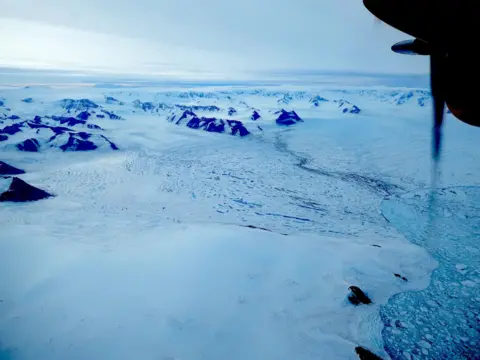 British Antarctic Survey
British Antarctic SurveyWhat followed was further loss of floating ice from the front of Hektoria, as large, flat-topped icebergs broke off or "calved", and the ice behind sped up and thinned.
That is not unusual. Iceberg calving is a natural part of ice sheet behaviour, even though human-caused climate change makes the loss of ice shelves much more likely.
What was unprecedented, the authors argue, was what happened in late 2022, when they suggest the front of the glacier was "grounded" - resting on the seabed - rather than floating.
In just two months, Hektoria retreated by 8.2km. That would be nearly ten times faster than any grounded glacier recorded before, according to the study, published in Nature Geoscience.


This extraordinary change, the authors say, could be thanks to an ice plain - a relatively flat area of bedrock on which the glacier lightly rests.
Upward forces from the ocean water could "lift" the thinning ice essentially all at once, they argue - causing icebergs to break off and the glacier to retreat in quick time.
"Glaciers don't usually retreat this fast," said co-author Adrian Luckman, professor of geography at Swansea University.
"The circumstances may be a little particular, but this rapid retreat shows us what may happen elsewhere in Antarctica where glaciers are lightly grounded, and sea-ice loses its grip," he added.

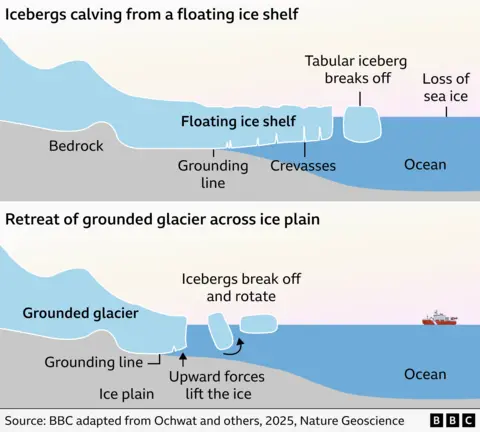
What makes this idea even more tantalising is that this process has never been observed in the modern world, the authors say. But markings on the seafloor suggest it may have triggered rapid ice loss into the ocean in the Earth's past.
"What we see at Hektoria is a small glacier, but if something like that were to happen in other areas of Antarctica, it could play a much larger role in the rate of sea-level rise," said Dr Ochwat.
That could include Thwaites – the so-called "doomsday" glacier because it holds enough ice to raise global sea-levels by 65cm (26in) if it melted entirely.
"It's really important to understand whether or not there are other ice plain areas that would be susceptible to this kind of retreat and calving," Dr Ochwat added.
But other researchers have contested the study's findings.
The controversy surrounds the position of the "grounding line" or "grounding zone" - where the glacier loses contact with the seabed and starts to float in the ocean.
"This new study offers a tantalising glimpse into what could be the fastest rate of retreat ever observed in modern-day Antarctica," said Dr Frazer Christie, glaciologist and senior Earth observation specialist at Airbus Defence and Space.
"But there is significant disagreement within the glaciological community about the precise location of Hektoria Glacier's grounding line because it's so difficult to get accurate records from radar satellites in this fast-flowing region," he added.
The location of the grounding line may sound trivial, but it is crucial to determine whether the change was truly unprecedented.
"If this section of the ice sheet was in fact floating [rather than resting on the seabed], the punchline would instead be that icebergs calved from an ice shelf, which is much less unusual behaviour," said Dr Christine Batchelor, senior lecturer in physical geography at Newcastle University.
"I think the mechanism and rate of retreat proposed are plausible in Antarctic ice plain settings, but because of uncertainty about where the grounding zone was located at Hektoria, I am not fully convinced that this has been observed here," she added.
But where there is little debate is that the fragile white continent – once thought largely immune from the impacts of global warming – is now changing before our eyes.
"While we disagree about the process driving this change at Hektoria, we are in absolute agreement that the changes in the polar regions are scarily rapid, quicker than we expected even a decade ago," said Anna Hogg, professor of Earth observation at the University of Leeds.
"We must collect more data from satellites, so that we can better monitor and understand why these changes are occurring and what their implications are [for sea-level rise]."
Additional reporting by the Visual Journalism team


Sign up for our Future Earth newsletter to keep up with the latest climate and environment stories with the BBC's Justin Rowlatt. Outside the UK? Sign up to our international newsletter here.

 Getty Images
Getty ImagesOpenAI has signed a $38bn (£29bn) contract with Amazon to access its cloud computing infrastructure as it continues its run of major partnerships.
In 2025, the ChatGPT maker has signed deals worth more than $1tn with Oracle, Broadcom, AMD and chip-making giant Nvidia.
As part of the seven-year agreement, OpenAI will gain access to Nvidia graphics processors to train its artificial intelligence models.
The deal follows a sweeping restructure of OpenAI last week which saw it convert away from being a non-profit and changed its relationship with Microsoft to give OpenAI more operational and financial freedom.
"Scaling frontier AI requires massive, reliable compute," said OpenAI co-founder and CEO Sam Altman.
"Our partnership with AWS [Amazon Web Services] strengthens the broad compute ecosystem that will power this next era and bring advanced AI to everyone."
The deal reflects the massive demand for computer power coming from the growing interest in AI.
Following the announcement of the deal on Monday, Amazon shares hit an all-time high, adding $140bn (£106bn) to its valuation.
In response to OpenAI's deal spree, there has been some speculation that an AI bubble may be in the offing.
Speaking to the BBC last month, Sam Altman said: "Yes, the investment loans are unprecedented", but added: "It's also unprecedented for companies to be growing revenue this fast."

© Michelle V. Agins/The New York Times

© Desiree Rios for The New York Times

在非洲国家刚果民主共和国(RD Congo),现总统费利克斯·齐塞克迪(président Félix Tshisekedi)政权要惩罚12个反对党。主管内政和安全事务的副总理宣布,他已向国务委员会提出了解散这些反对党的请求。这些反对党已在刚果(金)全国范围内被暂停活动,原因它们与前总统约瑟夫·卡比拉(Joseph Kabila)结盟,通过后者于10月中旬在肯尼亚首都创建了[拯救刚果民主共和国]平台(Sauvons la RDC)。
本台法广非洲组(RFI Afrique)在今天(2025年11月03日星期一)的更新法文报道中说,金沙萨方面谴责这次会议是与被判处死刑的卡比拉的“黑色弥撒”(messe noire)。卡比拉涉嫌支持[刚果河联盟/03月23日运动](AFC/M23)的叛乱。
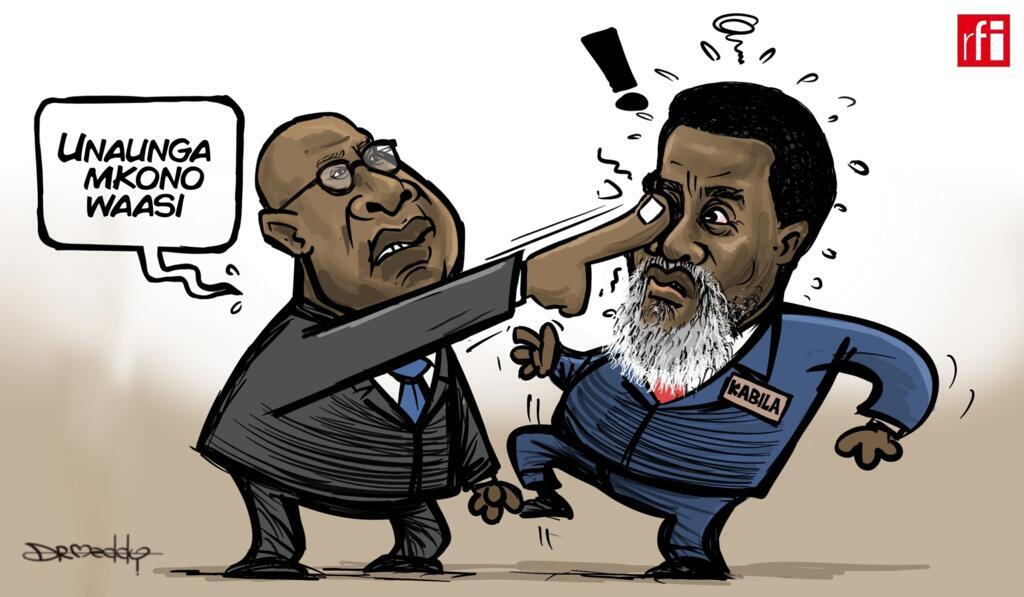
本台法广(RFI)非洲通讯员发自金沙萨(Kinshasa)的消息说,刚果民主共和国(RD Congo)政府宣布暂停所有参加了在肯尼亚首都内罗毕(Nairobi)举行的,由前总统约瑟夫·卡比拉(Joseph Kabila)召集的会议的政党的活动资格。此次会议启动了一个新的[拯救刚果民主共和国]平台(Sauvons la RDC)。在此之前,包括前国家元首的[争取重建与民主人民党](PPRD-Parti du peuple pour la reconstruction et la démocratie)在内,只有三个政党因国家安全的名义被暂停。

本台法广(RFI)法文报道还注意到,2025年11月02日星期日,刚果(金)公民社会对12个政党被暂停活动一事做出回应。这一决定引起了非洲人权协会(ASADHO)的担忧。该协会认为这是刚果(金)在滑向威权的歧途(Dérive)。
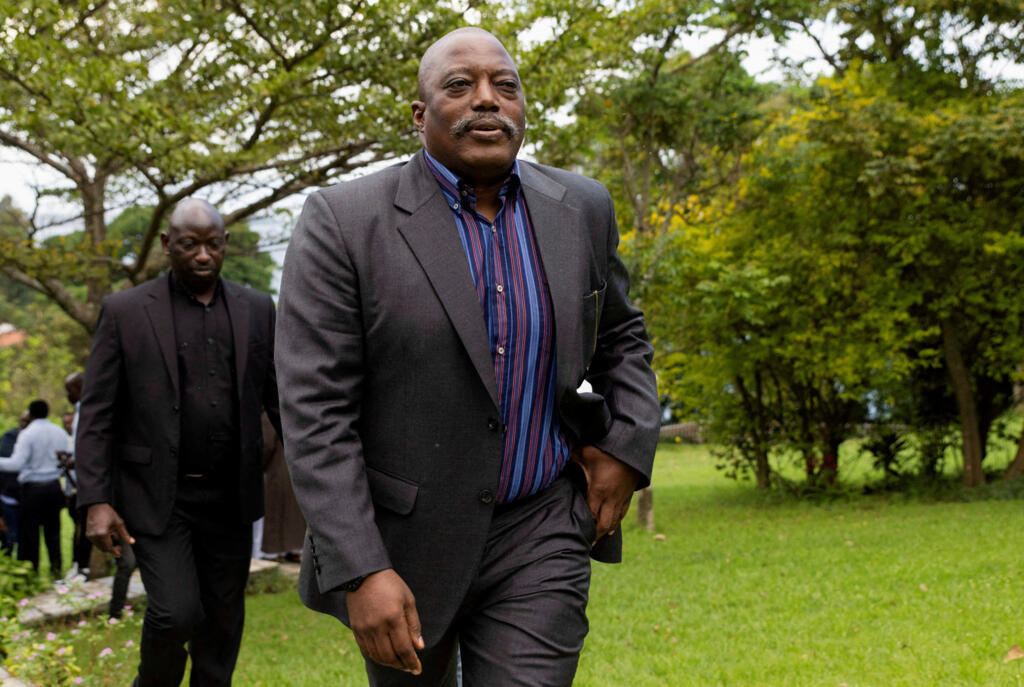
( 翻译和编辑:法广 RFI 电台 尼古拉 )
-. Fin .-

五角大楼负责人赫格塞斯与韩国防长安圭伯在举行第57次韩美安保会议前夕,访问了韩朝边界板门店。
周一,美国战争部长皮特·赫格塞斯访问了朝韩边境,这是八年来美国国防部长首次访问该地。
在参观了Ouellette观察哨后,韩国国防部长安圭培陪同赫格塞斯前往板门店——朝韩军队唯一对峙的地点。
首尔国防部在一份声明中表示,两位官员“重申了韩美两国共同防御的坚定立场以及密切的合作”。
韩国防长安圭伯和美国战争部长赫格塞思定于周二4日在首尔举行第57次韩-美安保会议(SCM)。
据韩联社消息:正式议题包括:对朝政策、联防态势、延伸威慑、安全合作、网络太空导弹合作、军工合作与国防科技合作。
除了韩国增加军费开支和提升驻韩美军战略灵活性等议题外,双方还可能探讨韩国建造核动力潜艇问题。
韩国总统李在明上月29日与美国总统特朗普举行会谈时,要求获得核动力潜艇燃料后,特朗普次日在社交媒体发文称,他“批准”韩国建造核动力潜艇。

 BBC
BBCA Scunthorpe United player and a Nottingham Forest fan are among the victims stabbed in a knife attack on a train in Cambridgeshire on Saturday evening. They are among 10 people injured on the train during the mass stabbing.
Footballer Jonathan Gjoshe, 22, and Forest fan Stephen Crean were travelling on a LNER train from Doncaster to London King's Cross when they were attacked at around 20:00 GMT.
Mr Crean has been hailed a hero after he confronted the train attacker, going face to face with him in the carriage.
Mr Gjoshe was slashed across the bicep and has been operated on, his club said.
Anthony Williams, 32, has been remanded in custody following the incident and is charged with 11 counts of attempted murder, two counts of possession of a bladed article and one count of actual bodily harm. One of the attempted murder counts relates to a separate incident.
Speaking to the BBC on Monday, Mr Crean's left hand could be seen heavily bandaged and he still had blood in his hair. He is one of the train passengers the 32-year-old is accused of attempting to murder.
Mr Crean described how he "tussled" with the man who was shouting at him as he slashed him on the head and hand.
He said he first saw people running down the train shouting that there was a man with a knife. As people ran to the buffet car he said he wanted to make sure passengers were safe.
"I saw him coming towards me - a guy with a rucksack and he's obviously got something in there.
"Everyone's gone towards the buffet, and that is on the verge of being full up. There's no-one else getting in there. I wasn't even going to bother pushing to get in.
"There's young women and they need to get them in. I confronted this guy, because I've got to make sure that the door's locked and I've looked around to save a bit of time.
"But then he started, he pulled this thing out. It was an over large blade thing".
Mr Crean said the man asked him: "Do you want to die? Do you want to die?"
"He's gone for me and there was a tussle in the arms with him and that's where my hand, the fingers are really bad, four cuts through them, sliced. And then he raised it and must have caught me when I was ducking and diving and must have caught me on the head."

 Scunthorpe United
Scunthorpe UnitedMr Crean says it's nice to hear that people are calling him a hero but that he wasn't the only one.
"It's lovely to hear. But I'd say there are other heroes like the police and the guys that got me off the train and the ambulances and the hospital staff, they're probably real heroes.
"And the train guy that's really badly injured. So, you know, it's a big shout to call someone a hero, but it's nice."
He says he was determined to confront the attacker to give another passenger time to close the buffet door.
"That door still wasn't shut behind me, because I could still see him struggling to close it. So until I knew it was I wasn't moving away from it."



 Supplied
SuppliedAn early morning train from Glasgow to London has derailed, seemingly after hitting a landslip, leading to major disruption set to last for "a number of days" on the West Coast Mainline.
At 06:10 GMT the 04:28 Avanti West Coast service from Glasgow Central to London Euston came off the tracks at Shap in Cumbria, the train operator said.
Lines north of Preston and south of Carlisle were blocked as a result, leaving passengers stranded either side of the crash.
The North West Ambulance Service said there were 87 people, including staff, on board and four suffered minor injuries that did not require hospital treatment.
A spokesperson for Avanti said: "It is likely there will be significant disruption to our network for a number of days."
The derailment has also hit TransPennine Express services which use the West Coast Mainline.


James Burrow, who was on the derailed service, said "there was a flash and a bang," before staff quickly informed passengers the train had derailed.
He said he was escorted off the train at 08:50 to go to the nearby Shap Wells Hotel.
"People were confused but calm," Mr Burrow said.
"At first we thought a car or something had hit the train.
"I was taking a picture of the train and a man came and said 'I was driving that'.
"He's kind of a hero really, it could have been a lot worse."
After being kept at the hotel, passengers were transferred to two coaches - one heading to London and the other going back up to Scotland.
Campbell Watson, from Glasgow, told BBC Radio Cumbria: "I was sleeping and there was a big jolt on the train, a real big screech and then all of a sudden the train came to a stop and the power went off.
"It was a very shocking experience."

 Reuters
ReutersNetwork Rail confirmed a landslip had occurred in the area before the train derailed, however it was still trying to determine whether that was the cause of the service coming off the tracks.
BBC Weather lead presenter Helen Willetts said it was a wet weekend in Cumbria.
"In the last three days, 77.4mm of rain has fallen," she said.
"It's a wet time of year, but that's over a third of the expected rainfall for November."
Shap Parish Council chairman Jean Jackson said "the rain is phenomenal" around Cumbria.
Combined with the "steep slopes" that are next to the railway line, she was "not surprised" that there was a landslip.
Last year there were delays after heavy rain caused a landslip on the same stretch of track.
Director of operations at Network Rail Sam MacDougall said Cumbria posed these "specific challenges" because of the regional weather and topography.
The disruption will continue until at least the end of Monday as lines remain blocked by the derailed train. This means:
TransPennine has warned that an hourly rail replacement bus running between Preston and Carlisle is "proving difficult" due to the limited supply of coaches.
Tickets for travel on Monday will be accepted on Tuesday.
Meanwhile, Avanti and TransPennine tickets are being accepted on the following services:
On the West Coast Mainline itself, trains from the south were travelling no further than Preston, while services from the north were terminating at Carlisle.
The Liberal Democrat MP for Westmorland and Lonsdale, Tim Farron, said he has spoken to Network Rail about the damage to the line and what the next steps would be.
He said he will be raising the issue in the House of Commons with the transport secretary and discussing the long term infrastructure on the West Coast Mainline.
Scotland's First Minister John Swinney said he was "very concerned" about the derailment and it was an "absolute relief" that no-one was injured.
He said he was in touch with the UK government to make sure anyone affected was "properly supported".

 IDF
IDFThe former top lawyer in the Israeli military has been arrested, as a political showdown deepens over the leaking of a video that allegedly shows severe abuse of a Palestinian detainee by Israeli soldiers.
Maj Gen Yifat Tomer-Yerushalmi resigned as the Military Advocate General of the Israel Defense Forces (IDF) last week, saying that she took full responsibility for the leak.
On Sunday, the story took a darker turn when she was reported as missing, with police mounting an hours-long search for her on a beach north of Tel Aviv.
She was subsequently found alive and well, police said, but was then taken into custody.
The fallout from the leaked video is intensifying by the day.
Broadcast in August 2024 on an Israeli news channel, the footage shows reserve soldiers at the Sde Teiman military base in southern Israel taking aside a detainee, then surrounding him with riot shields to block visibility while he was allegedly beaten and stabbed in the rectum with a sharp object.
The detainee was subsequently treated for severe injuries.
Five reservists were subsequently charged with aggravated abuse and causing serious bodily harm to the detainee. They have denied the charges have not been named.
On Sunday, four of the reservists wore black balaclavas to hide their faces as they appeared at a news conference outside the Supreme Court in Jerusalem along with their lawyers, who demanded the dismissal of their trial.
Adi Keidar, a lawyer from the right-wing legal aid organisation Honenu, claimed his clients were subject to "to a faulty, biased and completely cooked-up legal process".

 Anadolu via Getty Images
Anadolu via Getty ImagesLast week, a criminal investigation was launched into the leaking of the video.
Gen Tomer-Yerushalmi was put on leave while the inquiry took place.
On Friday, Defence Minister Israel Katz said she would not be allowed to return to her post.
Shortly after that, Gen Tomer-Yerushalmi resigned.
In her resignation letter, she said she took full responsibility for any material that was released to the media from the unit.
"I approved the release of material to the media in an attempt to counter false propaganda against the army's law enforcement authorities," she said.
That is a reference to efforts by some right-wing political figures in Israel to claim that the allegations of severe abuse of the Palestinian detainee had been fabricated.
She added: "It is our duty to investigate whenever there is reasonable suspicion of acts of violence against a detainee."
After her resignation, Katz issued a fierce condemnation of her conduct.
"Anyone who spreads blood libels against IDF troops is unfit to wear the army's uniform," he said.
Prime Minister Benjamin Netanyahu echoed his defence minister's words on Sunday, saying that the incident at Sde Teiman was "perhaps the most severe public relations attack that the State of Israel has experienced since its establishment".
Hours later, the first reports began appearing in the Israeli media that Gen Tomer-Yerushalmi was missing, sparking fears that a political scandal had taken a turn towards tragedy.
A massive search effort was launched. Several hours later, she was found "safe and in good health" in the coastal area of Herzliya, Israeli police said.
Overnight, a police spokesperson announced that two people had been arrested on suspicion of "leaking and other serious criminal offences" as part of an investigation.
Israeli media reported that the pair were Gen Tomer-Yerushalmi and the former chief military prosecutor, Col Matan Solomosh.

 Reuters
ReutersThe Sde Teiman incident has been a lightning rod for the division between the left and right in Israel.
On the right, the leaking of the video is denounced as a defamation of the Israeli military, all but amounting to an act of treason.
After Israeli military police went to Sde Teiman to question 11 reservists over the incident in July 2024, far-right protesters - including at least three lawmakers from Netanyahu's governing coalition - broke into the facility to show their support.
On the left, Gen Tomer-Yerushalmi's decision to enable the footage to be released is seen as the one time she lived up to the responsibilities of her post.
The video is regarded by the left as concrete evidence backing up multiple reports of abuse of Palestinian detainees since the Hamas-led 7 October 2023 attacks on Israel.
Last October, a report by a UN commission of inquiry alleged that thousands of child and adult detainees from Gaza had been "subjected to widespread and systematic abuse, physical and psychological violence, and sexual and gender-based violence amounting to the war crime and crime against humanity of torture and the war crime of rape and other forms of sexual violence".
Israel's government said it rejected the accusations of widespread ill-treatment and torture of detainees, and insisted that it was "fully committed to international legal standards". It also said it had carried out thorough investigations into every complaint.
Passengers have described blood-covered seats and attempting to protect themselves with a bottle after a mass stabbing on a LNER train left 11 people injured and needing hospital treatment. Two remain in a life-threatening condition.
Police met the Doncaster-London King's Cross train as it made an unscheduled stop at Huntingdon in Cambridgeshire shortly before 20:00 GMT.
Alistair Day, who was travelling back to Hertford having watched Nottingham Forest, was on the train when the attack happened - having narrowly missed his original connecting service.
He joined others and hid in the train's buffet carriage as a fellow passenger confronted a man with a knife.
"I was just by the buffet car. It was odd. I was at the end of the carriage. All these kids were running up and I thought it was like a prank - Halloween or students," he said.
"Then they're getting louder and louder any sorts of people with blood on them [appeared] and I thought, 'Oh, bloody hell, this is not good.'
"I saw a guy flailing out - a fracas with arms going everywhere. I didn't see him that well because there were people in front of him.
"My initial thought was I'm going to sit there and try and do something but I changed my mind.
"We all jumped up and everyone kept running but I was next to the buffet car and the guys in the carriage were trying to close up the shutters and everything.
"So I said, no, you've got to let us in here. So I jumped in there - there were about 12 of us in there.
"I was the first one in, so I was in the corner. A young woman who I spoke to afterwards was by the window and the guy was at the window with his knife trying to get in. Obviously we'd locked it by then."
Joe, who was also travelling back from the Nottingham Forest v Manchester United match, said the scenes were "like something out of a movie".
The 24-year-old, from Peckham in south-east London, said: "I was texting my friends about my plans for that night and then people came rushing through from the carriage, running through, saying, 'You need to run, you need to run'.
"At first it didn't really register what was going on.
"And then quickly, I just dropped my stuff and I started running along with them.
"And then I looked back, and I could see this guy - he was quite a tall, black male, and he had a bloodied knife.
"You just looked around and there was blood just everywhere."
Joe continued: "We kept moving through the train. We could see him behind us coming through.
"The scariest thing was that I knew that because the stops at this stage of the journey are just Stevenage and King's Cross there's quite a lot of big distances between stops.
"So we had no idea how long we were going to be on the train for.
"The thing that was in my mind was we're running through this train now but what if we run out of carriages to run through? What if we reach the end of the train? What happens there?
"It all happened very quickly. I was just in a fight or flight mode really."

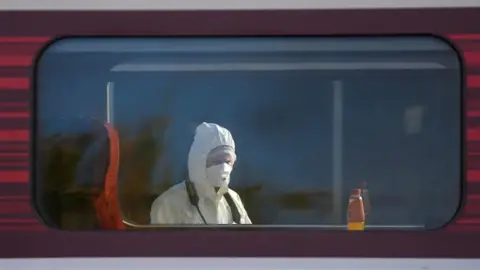 Joe Giddens/PA
Joe Giddens/PAOlly Foster, a passenger on the train, told the BBC he initially heard people shouting "run, run, there's a guy literally stabbing everyone", and believed it might have been a Halloween related prank.
He said within minutes, people started pushing through the carriage, and he noticed his hand was "covered in blood" as there was "blood all over the chair" he had leaned on.
An older man "blocked" the attacker from stabbing a younger girl, leaving him with a gash on his head and neck, Mr Foster said.
Passengers around him used jackets to try to staunch the bleeding.
He added that the only thing people in his carriage could use against the attacker was a bottle of whiskey, leaving them "staring down the carriage" and "praying" that he would not enter the carriage.
Although it lasted 10-15 minutes in total, Mr Foster says the incident "felt like forever".
Describing the scene when he got off the train, he said: "There were three people bleeding severely. One guy was holding his stomach and there's blood coming from his stomach and going down his leg.
"He was going 'help, help, I've been stabbed'."

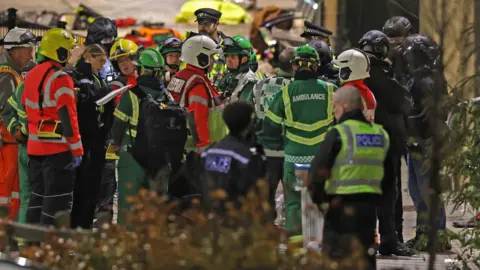 PA
PAThe train's only other scheduled stop before King's Cross was due to be at Stevenage.
Wren Chambers, who was due to get off in the Hertfordshire town, said they first became aware something was wrong when a man bolted down the carriage with a bloody arm, saying "they've got a knife, run".
Wren said they and a friend ran to the front of the train and saw a man who had collapsed on the floor.
Wren said they felt "stressed and pretty scared" once they knew what was happening, but they were eventually able to get off the train unharmed.
"There was quite a lot of blood on the train, there was some on my bag, some on my jeans," she told BBC Radio 5 Live.
"As soon as the train stopped and people got off most of them ran outside trying to get away from it, because we knew the attacker was still inside on the train."

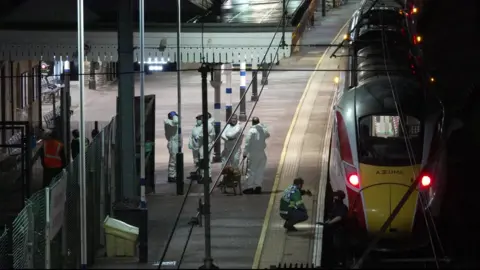 PA Media
PA MediaLondon Underground worker Dean McFarlane told the BBC that he saw the train pull into Huntingdon railway station at 20:00 with a passenger bleeding.
He said that on arrival, he saw multiple people running down the platform bleeding, with one man in a white shirt "completely covered in blood".
He said he grabbed people and told them to leave the station, and tried to assist passengers who he believed were having panic attacks.

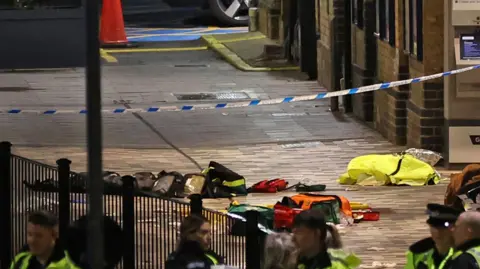 PA Media
PA MediaFollow Cambridgeshire news on BBC Sounds, Facebook, Instagram and X.
Passengers travelling from Doncaster to London have been attacked in a mass stabbing on Saturday night.
Ten people were injured and taken to hospital. Nine of them are believed to have life-threatening injuries.
Two people were arrested after the train made an unscheduled stop at Huntingdon, Cambridgeshire and witnesses reported that police used a Taser on one man holding a knife.
Counter-terror police have joined the investigation. Prime Minister Sir Keir Starmer said the attack was "appalling" and "deeply concerning".
Here is what we know so far about what happened.

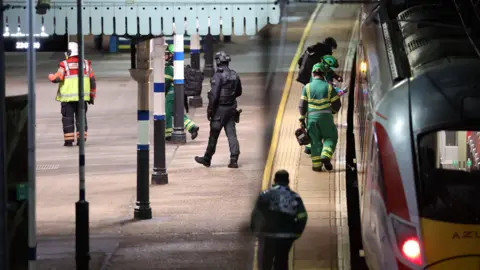 PA Media
PA MediaThe stabbing took place on the 18.25 GMT Saturday night LNER train service from Doncaster to London's King Cross station.
Passengers reported that at least one person brandishing a knife began stabbing people on the train after the train stopped at Peterborough, Cambridgeshire.
Witnesses told the BBC of panic and confusion.
Olly Foster, who was on the train, said he heard people dashing across carriages shouting "run, there's a guy stabbing literally everyone and everything" - and thought it might have been a Halloween-type prank.
Another passenger heard someone shouting, "someone's got a knife"
Some passengers hid inside the toilets while others swarmed towards the front of the train.
At 19:39, the train driver made an unscheduled stop at Huntingdon, Cambridgeshire, where dozens of armed police officers and emergency services rushed to the platform.
Witnesses said police used a Taser on one man. Two people, whose identities are not yet known, were arrested.
Altogether, the incident was estimated to last roughly 10 to 15 minutes.
The uninjured passengers were interviewed by police and some boarded a coach bound for London.
Emergency crews took 10 people to hospital, nine of whom are believed to have suffered life-threatening injuries, according to police.
The identities of the victims are not yet known.
Witnesses described some of the victims, including a man keeled over in pain on the platform, bleeding from his stomach.
Wren Chambers, a passenger on the train, told the BBC that one person had been stabbed in the arm and bolted down the train to alert others.
Olly Foster told the BBC how an older man had gashes on his head and neck after he "blocked" the attacker from stabbing a younger girl and passengers then used their jackets to try to staunch the bleeding.
London Underground worker Dean McFarlane told the BBC how he saw multiple people running down the platform bleeding, with one man in a white shirt "completely covered in blood".
London North Eastern Railway (LNER), which operates East Coast Mainline services in the UK, has urged passengers to avoid travelling on Sunday 2 November.
Ticketholders who are no longer planning to travel will be eligible for a full refund. Unused weekend LNER tickets will be valid until Tuesday 4 November.
Huntingdon station is not guaranteed to reopen on Sunday, LNER warned. Disruption to services between Stevenage and Peterborough are due to last all day.
Passengers are able to use their tickets on the following services without incurring extra cost:
• Avanti West Coast between London Euston, Manchester
• TransPennine Express between Manchester, Leeds and York/Newcastle
• ScotRail between Glasgow Central and Edinburgh Waverley
• Northern between Carlisle and Newcastle
• East Midlands Railway (EMR) between London St Pancras, Leicester and Sheffield.
• CrossCountry between Sheffield, Doncaster/Leeds, York and Newcastle/Edinburgh
• Greater Anglia between London Liverpool Street, Stevenage and Peterborough.
• Great Northern and Thameslink between London Kings Cross, Stevenage and Peterborough
• London Northwestern Railway services from Euston
LNER said delays are expected across the train system, including from other services and operators in the East of England and London, throughout Sunday.
Thameslink tickets that were not used on Saturday will be valid for Sunday.
In a statement published early on Sunday morning, LNER Managing Director David Horne wrote that he was "deeply shocked and saddened by this serious incident" and thanked emergency services for their "quick and professional" response.






© Chris Radburn/Agence France-Presse — Getty Images